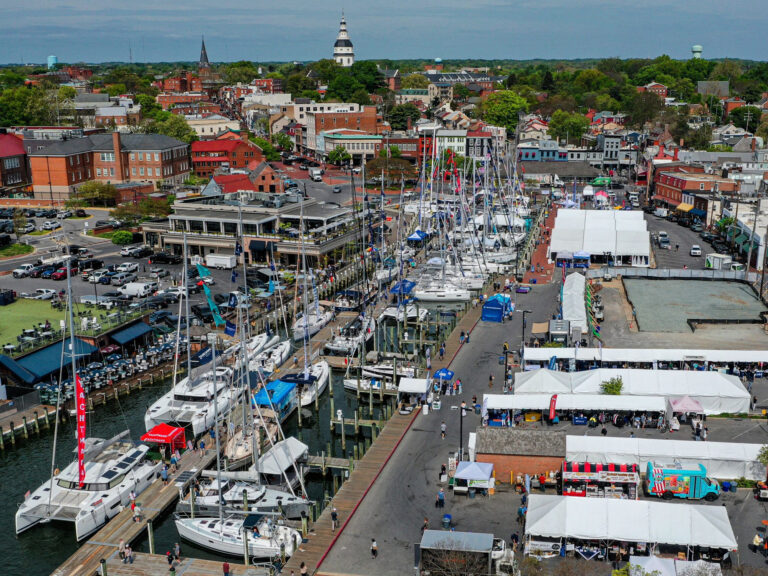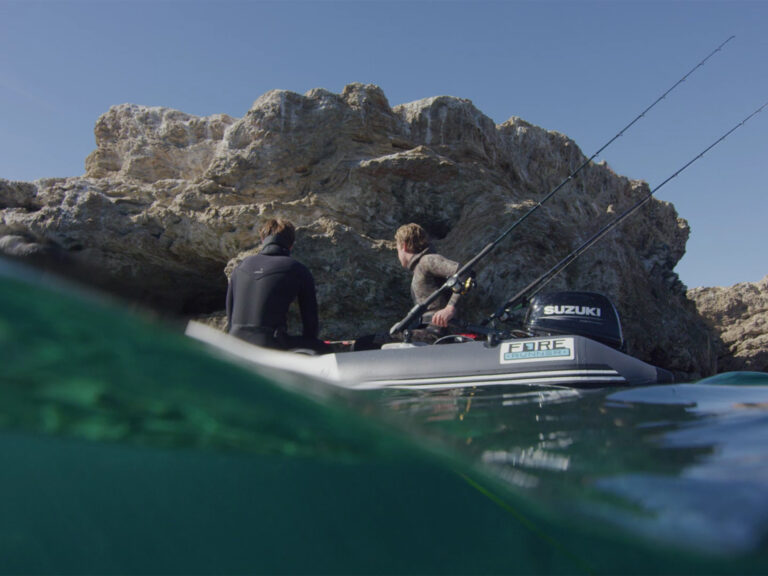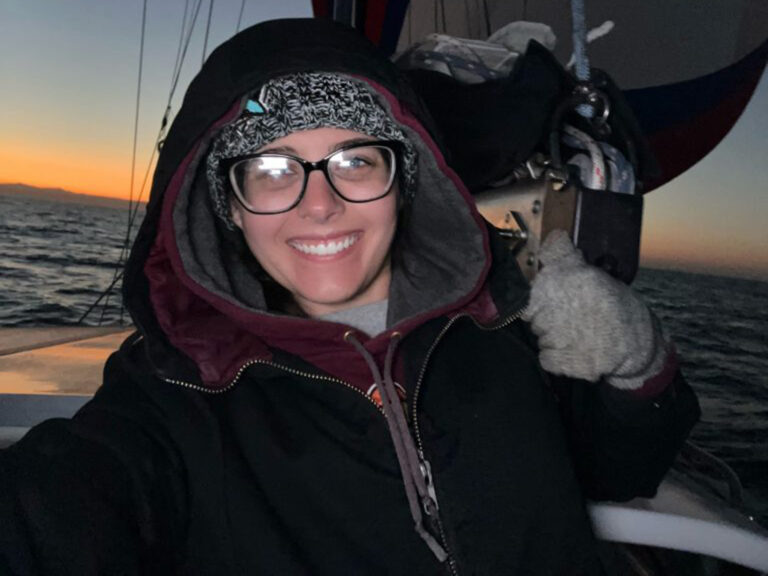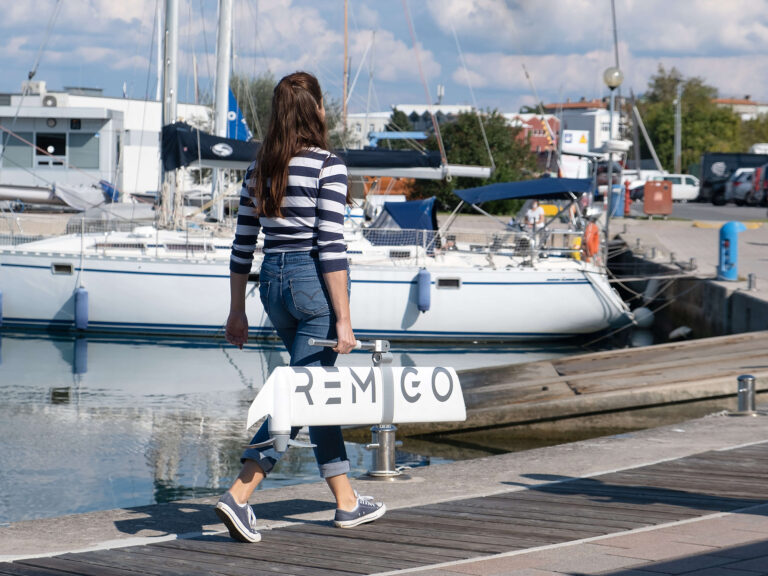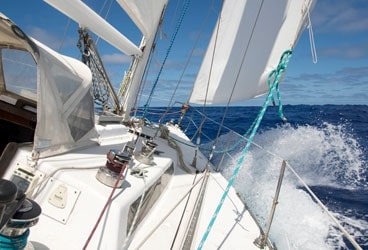
chiles round the world 368
From where The Hawke of Tuonela lay swinging peacefully in French Polynesia on a mooring off the most recent reincarnation of the Bora-Bora Yacht Club, it was 2,149 miles to her home at Opua, New Zealand.
From the beginning, I’d intended to complete this circle, my fifth, in less than 18 months. However, along the way I discovered that I was ahead of the pace of my first circumnavigation, 203 sailing days, at that time the world record, and I must admit that I now wanted to beat that time. If I could cover those 2,149 miles in less than 33 days, an average of only 65 miles a day, I would do it.
A former raceboat, The Hawke of Tuonela sails well. My Heritage One-Ton sloop has many more 24-hour runs of more than 160 miles than under 100 miles, and to that point in the voyage, she had only one day’s run of less than 65 miles. As I sat on deck the night before I left and watched locals paddle pirogues across Bora-Bora’s beautiful lagoon, I was confident.
Two and a half weeks later, I wrote in my ship’s log, “I might not break Egregious’ record after all. It was inconceivable that I’d make a passage this slow, but it isn’t any longer.”
Between the vision and the reality falls the shadow.
It began well enough.
I dropped the mooring at first light and powered across a smooth lagoon and out the pass, and when I set the main and genoa and turned southwest, my 37-foot green sloop made an easy six knots with the southeast trade wind on the beam. It was an easy return to the sea.
The wind weakened that afternoon, then strengthened after dark, giving us a rougher but faster ride for three days, with noon-to-noon runs of 137, 150, and 150 miles. On the fourth night, I saw the loom of light from Rarotonga, in the Cook Islands; the island itself was visible 16 miles to the south at dawn.
We were making a fast passage. And then we weren’t.
The wind faded. The Hawke of Tuonela began being thrown around on leftover seas. Rarotonga is a high island, but it’s not that high, and we were too far away to be in its wind shadow.
To stabilize us, I set the big asymmetric on the gennaker furling gear. It worked. My own white cloud got us moving at five knots, though 20 degrees high of course.
In midmorning, I jibed to point us west instead of south on what became, despite a falling barometer, a classic high-pressure day: pure blue sky, decreasing wind, smooth sea.
I took a solar shower in the cockpit, then listened to music on deck as The Hawke of Tuonela, heeling a few degrees, glided ever more slowly onward. By mid-afternoon, the wind was down to six knots, and our speed over the ground from the GPS was hovering at only around four knots.
Meanwhile, 7,000 or 8,000 miles behind us, my high school class was holding its 50th reunion. In absentia, I was given an award for being the person who’d traveled the farthest not to be there.
Before a passage, I’m often asked my plan, and my invariable reply is that “I will do what the wind lets me.” I look at the pilot charts, although I know that these are averages that may have no relevance to a single event. And after all these years and voyages, I hold the world in my mind. On this circumnavigation, I’d previously visited every place except the Cocos, or Keeling, Islands, so I generally know what to expect. Then I go and I adapt. Beyond Rarotonga, what the wind wouldn’t let me do was sail to New Zealand.
Light wind. No wind. Head wind. Gale. A formula for a slow passage.
By sunset, the fickle wind had all but died. The spinnaker drooped more than it flew. Our speed over ground was a dismal 1.9 knots.
In the dark cabin, I watched Pirates of the Caribbean; the next afternoon, just after I’d logged a day’s run of 67 miles, a pirate ship came over the horizon. At first I couldn’t believe my eyes as the tips of three masts appeared, then an entire fully rigged ship. The sails weren’t set. I was the only one trying to sail that day. The vessel was powering east, and it was a good day for it. I’ve encountered real pirates; this one seemed more likely either a training vessel or a cruise ship. I couldn’t make out the national ensign, but I know it wasn’t the Jolly Roger.
The ship powered steadily east until it disappeared, while we ghosted slowly west and didn’t.
Increasing low, white puffs of trade-wind cloud caused me to expect an increase in wind, and it came in late afternoon on the beam. I lowered the spinnaker, and changed to main and genoa. Seven to eight knots of breeze moved The Hawke of Tuonela at six knots, and when the wind rose all the way to 10 knots, our SOG was 6.7 to 7.1 knots across smooth seas. She needs so little, but she got less.
I fixed myself a gin and tonic, sans ice, and while drinking it on deck, enjoying The Hawke of Tuonela’s motion, I saw a dolphin rise beside the bow. Unlike some sailors, dolphin aren’t loners. You never see just one, and a moment later five other glistening backs arched from the water. Then more and more.
With Sarah Brightman singing from the cockpit speakers, I finished my drink, boiled water for freeze-dried babotjie, and ate dinner on deck.
Perfectly glorious.
But perfection doesn’t last. If it did, we wouldn’t recognize it.
A day’s run of 121 miles-normally disappointing, but a triumph in view of what was to come-was followed by one of 108 miles, and then 67, 82, 52, 56, 93, 97, 66, 88, 99, 81, 90, 146, 67, 90, and 73. That made 11 less-than-100-mile days in a row, and 14 days out of 15. It was by far the two slowest weeks of the entire circumnavigation, and they came back to back.
The days were mostly beautiful and sunny. The nights were mostly lousy, but not always in the same way. Variety is everything. I was awake most of one night while The Hawke of Tuonela lurched and rolled, the jib collapsed and refilled, sheets and blocks banged. And awake most of the next after a line of clouds from the west just before sunset caused me to lower the spinnaker that I’d set that morning. I sat on the foredeck, leisurely coiling the sheets and furling line-after all, we weren’t going much more slowly with the sail down than we were when it was up-and watching clouds overrun the sky before setting the jib.
In an hour, we had a 25- to 30-knot head wind. Rain pounded on the deck, accompanied by lightning and thunder. At 2200 it abruptly stopped, and I set the mainsail with a single reef because in darkness complete except for a sinister, swollen, orange sliver of moon, I couldn’t tell if more wind and rain were coming.
For the rest of the night, we rattled and slatted, except for three times when I found us sailing slowly east and with the jib backed.
During passages, I routinely have my instrument system display SOG and course over ground, both taken from the GPS, on the interfaced chart plotter rather than speed and heading from the system’s own paddlewheel transducer and fluxgate compass. After several failed attempts at balancing The Hawke of Tuonela, I realized that under these conditions that was a mistake. I switched from COG to the fluxgate compass’s true heading and found them to differ by almost 180 degrees. Although the bow was pointing west, the GPS showed us sailing east. It couldn’t tell that we were going there backward. There are truths you don’t want to know.
For a few days the wind died almost completely, and we set new records for the slowest days of the circumnavigation: 52 and 56 miles. Most of those were made with the spinnaker collapsing and filling, on average, eight times a minute. I timed it.
I stopped thinking about the end of the passage and focused only on the next small artificial increment: reaching the last time zone, Greenwich Mean Time, plus or minus 12, at 172 degrees 30 minutes west on September 28. Crossing 30 degrees south on October 2. Passing from the Western Hemisphere to the Eastern Hemisphere at 180 degrees on October 5. This one wasn’t easy. We finally had wind. But too much-25 to 30 knots, gusting higher-and from the wrong direction: directly ahead.
At noon, we were 18 miles from the international date line. Four hours later, we were a single mile east of it.
Earlier in the year, I’d tacked The Hawke of Tuonela through 55 degrees, with the Agulhas Current behind me. Now, under double-reefed mainsail and deeply furled jib while sailing in jagged, four- to six-foot waves, we tacked through 140 degrees. Not by compass but by COG. Our choices were south or northwest. South was closer to Opua’s bearing of 239 degrees, so I pointed us that way, and six hours later we made the mile west and finally crossed 180 degrees.
New Zealand’s weather is characterized by change. Highs and lows chase one another rapidly across the Tasman, so when the wind blew hard from the southwest, I wasn’t concerned. Any wind was better than no wind, particularly when it could be expected to change direction in 24 hours or so, and when it did, The Hawke of Tuonela would make miles.
After the initial gusts, the wind settled in around 20 knots. The days continued mostly sunny, though cool. Shorts and T-shirts gave way to Levi’s and fleece. I was close enough to New Zealand to receive broadcast radio, and I learned that a freak spring snowstorm had stranded motorists in the middle of the North Island. I started living in my foul-weather gear, both to be ready to go on deck if something broke and because The Hawke of Tuonela isn’t a dry boat going to windward in more than 20 knots. Often I wore a hat to keep drips from falling on my head while sitting in the cabin. And the wind blew from the southwest for a week.
We often made five and six knots, but almost never in the right direction. The limiting factor wasn’t how fast The Hawke of Tuonela could go-I could’ve pushed her easily to seven knots-but how often she leaped off a wave and crashed into the trough beyond. Many days we covered 140 miles over the bottom, tacking back and forth every few hours, only to have day’s runs between noon positions of less than 100 miles, and not all toward Opua.
On deck or below, I’m always sailing the boat. On deck, my eyes move from the sea to the luff of the jib to the instrument displays in a continuous loop. Belowdecks, I notice the angle of heel and the sounds of the water moving past the hull, and even when reading, I often glance at a Micronet display I keep nearby. That week it all became too discouraging, and I turned off both the instrument system and the chart plotter.
Day after day, I found myself standing in the companionway and staring forward at endlessly whitecapped waves marching toward us, seeking some sign of a break or change. What was most painful is that these were wonderful days for sailing-just not toward New Zealand. The wind had only to veer or back 20 or 30 degrees and I could then ease sheets. The Hawke of Tuonela would cease crashing off waves, and we’d be making 160 miles a day.
Relief at last came in the form of a welcomed gale.
I’d heard about the low on New Zealand radio, but I’d have predicted it myself from the clouds and falling barometer. As the low approached, it bent the wind to the north. At sunset, we were only 146 miles from Opua. The wind was forecast to blow 35 to 40 knots the next day, Friday, then return to the infernal southwest at 30 knots on Saturday.
The Bay of Islands is one of the few places in the world that I’ll enter after dark. I’d done so on my last return passage from Fiji. These have become my home waters, and the quarantine dock is long and easy to approach. This passage, which I’d expected to take two and a half weeks, had already taken three and a half. I didn’t want to face 30 knots on the nose on Saturday. I wanted to get in.
As the wind continued to veer and increase during the night, the main blanketed the jib, and I lowered it at 0200. By dawn, we had 20 to 25 knots, and I deeply furled the jib in anticipation of more. Our speed remained at six knots. A waypoint near Cape Brett at the entrance to the Bay of Islands was 77 miles away.
At 0900, the instrument system was showing apparent wind of 25 to 30 knots, with occasional gusts to 35. The Hawke of Tuonela was moving ahead of it relatively smoothly. The barometer was down to 999 millibars, having plunged a dramatic 17 millibars lower in 24 hours. With such a drop, I was surprised that the wind wasn’t stronger.
I was in the cockpit repeatedly in intermittent cold rain, letting out and taking in the jib. I didn’t want to overpower the Monitor, but I wanted to be off Cape Brett at sunset. Often a single roll on the furling gear made a half-knot difference in boat speed.
At 1100, there were two unexpected changes. The sky began to clear to the northwest, and the wind began to back. By noon, we were 46 miles from Cape Brett and in trouble. The wind was forward of the beam, and we were being pushed south of the cape.
Sometimes the center must hold.
I went on deck and raised a deeply reefed main.
Waves swept the deck while I was setting the sail. The halyard and clew reefing lines run to the cockpit, but I was at the mast to tie in the tack line, which doesn’t take long, and at the boom for the reef points, which took longer because I frequently had to drop what I was doing and hang on with both hands.
Back in the cockpit, I was winching in the clew line when we flew off a wave and tension on it suddenly released, causing me to fall backward. Fortunately, I didn’t land on anything with a sharp corner.
Main trimmed, I turned us closer to the wind with the Monitor control lines. We didn’t have enough sail to power through the waves, and our speed dropped to four knots, so I unfurled more jib until our SOG was back to six and our COG was 220 degrees, above the 210-degree bearing of Cape Brett. Now I wanted to know the truth from my instruments.
Throughout the afternoon the wind continued to back; by 1500, we were closehauled, heeled 30 to 40 degrees, and smashing into nine-foot waves. Then the wind, perhaps influenced by the land 30 miles away, began to veer, and I knew that if nothing broke, we were going to make it.
I sailed The Hawke of Tuonela harder that afternoon than perhaps I ever have. I spent most of it in the cockpit in rain, grateful that I’d bought new foul-weather pants to replace the last pair, which were no longer waterproof. Sheets of water swept the deck, hitting me with solid body blows. Sailing to windward in a gale is a contact sport.
Finally the wind had veered enough so I could lower the mainsail and continue under deeply furled jib. Although the sun was visible below the clouds as it neared the horizon, there was still no sign of the land that the chart plotter said was only 20 miles away. Not until Cape Brett light became visible at 1930 was I certain that New Zealand was really there.
I let us sail for another hour before I went on deck to change from jib to engine and Monitor to tillerpilot.
I set up the tillerpilot first, then started the engine, which I’d test-run for half an hour the day before. It started right up and ran just long enough for me to furl the jib before sputtering to a stop. Almost simultaneously the bracket connecting the tillerpilot to the tiller snapped. A shout of frustration split the dark night, and it temporarily damaged a sailor’s voice.
Re-engaging the Monitor and unfurling a bit of jib to get us under control, I then went below to check the engine and find a spare tiller bracket. We were three miles north of Cape Brett and in no immediate danger, so this was at worst only an inconvenience. I could sail us to within anchoring distance of the quarantine dock and possibly all the way up to it, even if it took all night instead of two hours under power.
From the sound of the diesel and the way we’d leaped around that afternoon, I concluded that air had gotten into the fuel line. Thanks to a mechanic who’d installed an inline squeeze bulb, bleeding my little Yanmar isn’t difficult, even at sea, and after two tries, the engine started and didn’t stop.
Getting the broken tiller bracket off and the new one on required removing nuts from two bolts while the tiller was being moved by the Monitor, but it got done. An hour later, we were again under power and tiller pilot.
I checked our position on the chart plotter, then sat on deck to let my eyes adjust to the darkness. Looms of light ahead were from Russell and Paihia. A flashing light abeam was on a rock, just off a line of small islands separated from the mainland. There was relief in knowing where we were and being able to picture my surroundings in my mind.
The mouth of the Bay of Islands is several miles wide, so the seas were still rough, but they steadily abated as we moved west. I went forward to put the anchor in place and to drag 75 feet of chain on deck before dropping it back below to be certain it wasn’t snarled.
Off Russell, I put out our dock lines and fenders.
The last hour was beautiful.
With everything in place, I stood still in the cockpit.
The water was smooth now. The wind had almost died. Midnight had passed. Only two miles to go. The waning gibbous moon came up over vineyard-covered hills to the east to join Orion.
A red light on a buoy to port, and a final curve between hills. I could barely make out boats moored on both sides of the channel. Ahead I saw the red light on the end of the marina breakwater float that serves as the quarantine dock. I took off my foul-weather pants to have greater mobility and disengaged the tillerpilot, took the tiller myself, and cut the engine to quarter speed.
Two hundred yards off, I shifted to neutral. A large sailboat was tied to the Q dock. There was plenty of room for me behind the boat or in front. I put the engine back in gear and eased us forward.
In the end, I couldn’t have asked for better conditions. In neutral again, The Hawke of Tuonela glided to the Q dock. I stepped off and secured bow, stern, and spring lines. When I looked at my watch a minute later, it was 0045 on October 10, 2009, ship’s time; 1245 on October 9, 2009, GMT. Total sailing time for the circumnavigation: 193 days and 10 hours.
I stepped back aboard and poured a tiny amount of the Laphroaig I’d been saving for that moment into a crystal glass. I was too tired to have more. I drank it in the cockpit. Everything was so quiet, so still.
I’d raced myself around the globe and won, but only because I had a big lead going into the final leg.
I went below and couldn’t sleep.
After spending the winter in Chicago, Webb Chiles is planning his return to the Bay of Islands.




